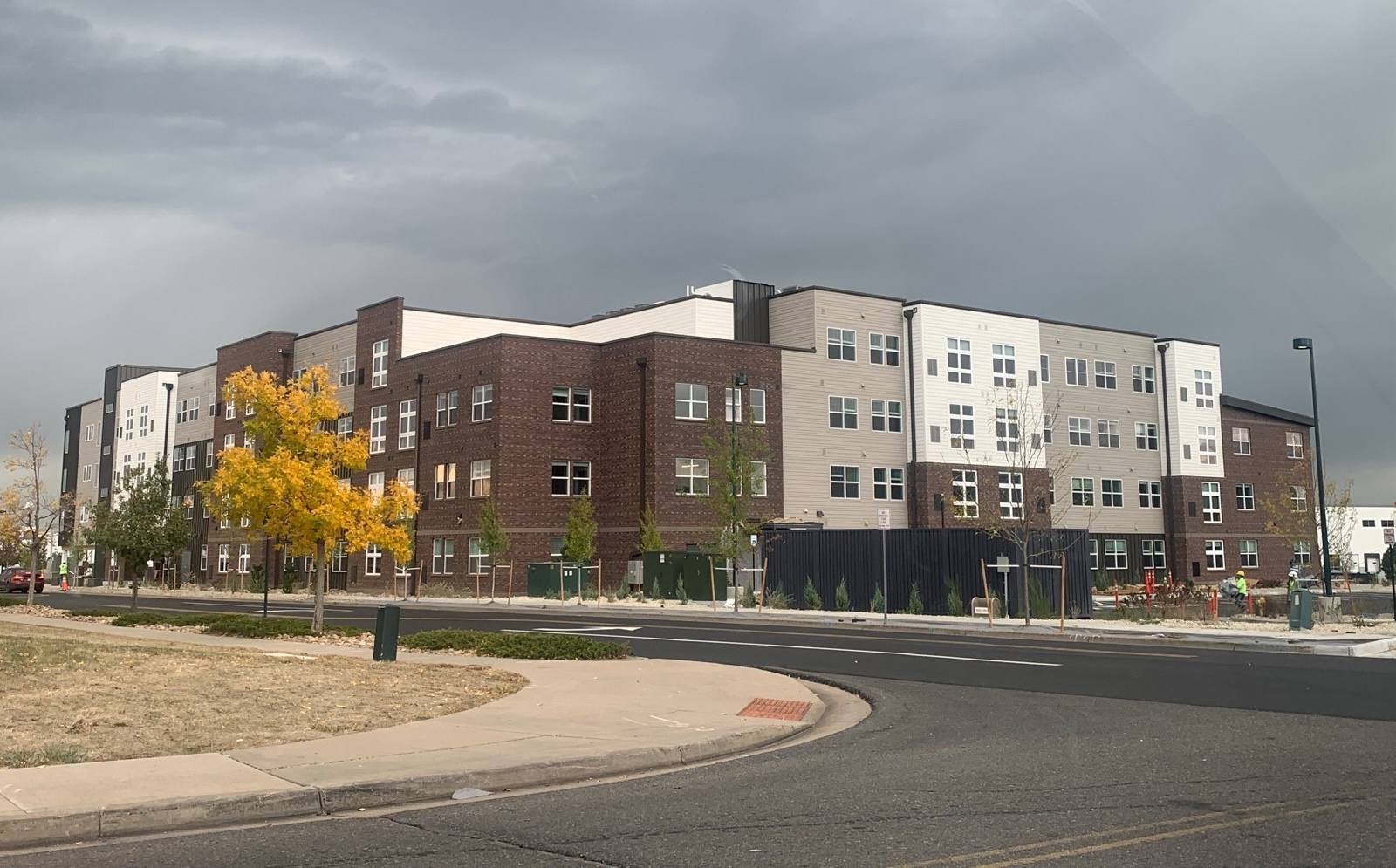Overview
Walden35 is an all-electric affordable apartment community serving residents with incomes up to 70 percent of the Area Median Income (AMI). The development, completed in October 2023, is located in a largely commercial area on the east end of Aurora. Walden35 was developed by the Aurora Housing Authority (AHA) to help address the shortage of affordable housing in this area of the city, especially for those households that often fall just outside of affordability requirements. The 100-unit development features amenities such as a dog park, a courtyard with a playground, and walkability to nearby retail.
|
Project Location |
Aurora |
|
IECC Climate Zone |
5 |
|
HTC Deal Type |
Federal 4 percent Housing Tax Credits |
|
Completed |
|
|
Size (sf) |
89,289 |
|
Levels (#) |
4 |
|
Units (#) |
100 total |
|
Buildings (#) |
1 |
|
Construction Type |
New construction |
|
Fuel Type |
All-electric |
|
Green Building Certifications |
National Green Building Standard - Bronze |
|
Total Development Cost |
$37,200,000 (2023) |
|
Operational Cost (PUPA) |
$5,035 |
Planning and Design Approach
AHA has noticed that the demand for affordable units has recently rivaled and even outpaced the demand for market-rate units in Colorado, and AHA has seen an increase in local and out-of-state contractors interested in affordable housing. This increased capacity and interest, coupled with the shortage of affordable units in the east end of Aurora, guided the site selection for Walden35.
Due to its location, land use planning for the Walden35 parcel had to satisfy the Sand Creek Metro District and the City of Aurora. With the high number of stakeholders involved in this project, it was important to lead a collaborative design process to achieve outcomes that would incorporate elements important to each.
AHA has been developing all-electric buildings since 2018. The decision to pursue this strategy came from the desire to keep pace with development trends and policies, including Governor Polis’ goal for the State of Colorado to achieve carbon neutrality by 2050.
Electrification Strategies and Features
|
Water Heating Individual electric resistance water heaters |
|
Space Heating and Cooling Individual vertical terminal heat pumps |
|
Ventilation Natural ventilation |
|
Cooking Electric resistance stoves |
Financing and Cost
The total development cost (TDC) of Walden35 was $37.2 million. The per unit per annum (PUPA) cost is $5,035 (2024). This is significantly lower than the Arapahoe County average of $8,572 (CHFA Per Unit Per Annum (PUPA) Reporting).
Like many recent developments, Walden35 was impacted by high construction and material costs due to supply chain interruptions caused by the COVID-19 pandemic. To curb some of these escalating costs, AHA signed a materials purchase contract early on to secure a lower price on materials. AHA paid up-front for the materials, and their general contractor stored them in a warehouse nearby. This was the first time AHA used this strategy to avoid cost escalation, and felt it was successful. The AHA team also noted that interest rates were favorable at the time of development, compared to more recent projects.
Successes
Walden35 has successfully addressed an urgent need for affordable housing in east Aurora with an all-electric development. This infusion of housing in the area has provided low- and middle-income residents with access to nearby jobs and retail. Additionally, AHA has utilized community solar to reduce operating costs, effectively delivering the cost-saving benefits of renewable energy to residents without developing on-site solar. Walden35 is an excellent example of a developer employing all-electric technology while prioritizing lower first-costs but finding creative ways to drive down operating costs.
Lessons Learned
AHA has gleaned several important lessons throughout Walden35’s development process that are relevant to multifamily affordable housing developers in Colorado.
While community solar subscriptions are a useful method for offsetting some of the operating costs associated with building electrification, it is important that developers have this conversation early in the design process, as certain electrical metering approaches may not be conducive to community solar subscriptions. AHA was able to coordinate with their community solar provider to determine the best approach for Walden35.
One of the biggest challenges faced in the development of Walden35 was a complication with the electric breakers. Just before residents moved in, AHA noticed that several of the units’ breakers were being tripped by small actions, like opening the refrigerator door. AHA learned that the model of electric breakers they had used were undersized for the electrical load in each apartment, and had to be replaced quickly so that all units were in working order before residents moved in. AHA recommends that any developers considering all-electric building conduct plenty of research and energy modeling with an experienced consultant to ensure that they do not run into similar issues.
Finally, when Walden35 was developed, many of the unique funding, financing, and incentive opportunities for all-electric development that exist today were not yet available. AHA’s approach prioritized lower up-front costs, often guiding them toward less efficient building systems. Today, many federal and state incentives such as the 45L Tax Credit for Zero Energy Ready Homes are helping developers of affordable housing access higher-efficiency systems within budget. These incentive opportunities are evolving rapidly, and developers should work with their consultants and local officials to determine which are available and applicable for their buildings.
Project Team
|
Developer |
|
|
Architect |
|
|
General Contractor |
|
|
Structural Engineer |
|
|
Civil Engineer |
|
|
Mechanical, Electrical, and Plumbing (MEP) Engineer |
|
|
Energy Engineer |
